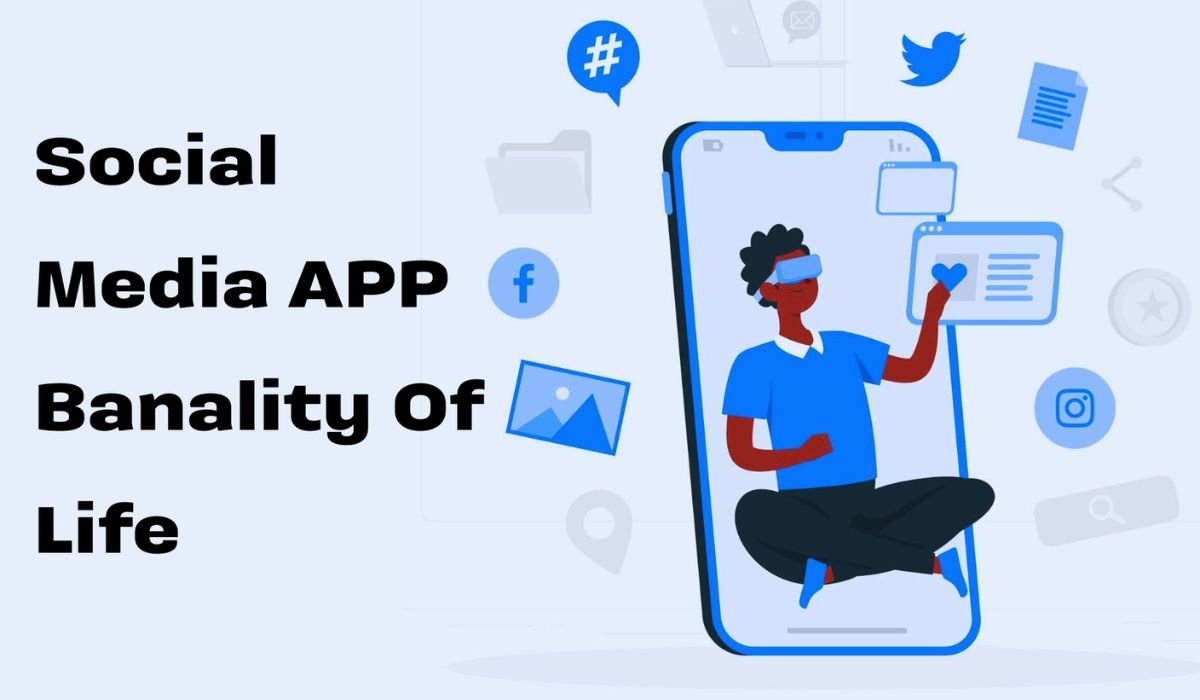Introduction
The Unchanging Scroll: A Look into Social Media’s Endless Loop
Imagine opening your favorite social media app, only to be greeted by a familiar sight—endless photos of perfectly arranged food, snapshots of exotic vacations, and a barrage of selfies. It’s almost as if the entire world has conspired to create a digital echo chamber where the same themes are repeated ad nauseam. This is the essence of social media app banality—the overwhelming sameness of content that fills our feeds and dulls our online experience.
Thesis Statement: Social media app banality refers to the repetitive and predictable nature of content on platforms like Instagram, Facebook, and TikTok. While these platforms are designed to connect us, the homogeneity of what we see can have a significant impact on users, leading to a loss of authenticity, increased feelings of inadequacy, and even negative effects on mental health.
Overview: This article will explore the concept of social media app banality by examining the monotonous scroll of content, the loss of authenticity in online interactions, and ways to break free from the cycle of repetitive content.
The Monotonous Scroll
Common Themes: The Repetition of Digital Life
One of the most striking aspects of social media app banality is the repetition of content across different platforms. Regardless of whether you’re on Instagram, Facebook, or TikTok, certain themes dominate:
- Food Photos: From avocado toast to intricate latte art, food photography has become a staple of social media. While these images can be visually appealing, the sheer volume of them can make our feeds feel redundant.
- Selfies: The ubiquitous selfie is another common theme. Whether it’s in a bathroom mirror or against a scenic backdrop, the flood of selfies contributes to the sameness of the social media experience.
- Vacation Pics: Exotic beaches, historic landmarks, and picturesque mountains are all popular subjects for vacation photos. However, as beautiful as these images may be, they often blur together into a sea of similar posts.
The Algorithm’s Role: How Popularity Shapes Content
The repetition of content on social media isn’t just a coincidence—it’s often driven by the algorithms that power these platforms. Social media algorithms are designed to prioritize content that garners the most engagement, such as likes, shares, and comments. This creates a feedback loop where popular content is more likely to be seen, leading users to create similar posts in the hopes of achieving the same level of attention.
- Popularity Over Diversity: Algorithms tend to favor content that appeals to the widest audience, which often means that more niche or unique posts are less likely to be promoted. As a result, users are incentivized to stick to familiar themes that they know will perform well.
- The Echo Chamber Effect: As users engage with certain types of content, algorithms learn to show them more of the same. This creates an echo chamber where users are exposed to a narrow range of ideas and visuals, further contributing to social media app banality.
The Impact of Filters and Editing: The Homogenization of Reality
Another factor that contributes to the sameness of social media content is the widespread use of filters and editing tools. These features allow users to enhance their photos and videos, often in ways that make them look more polished and aesthetically pleasing. However, this can also lead to a homogenization of content, where everything starts to look the same.
- Unrealistic Expectations: The use of filters can create unrealistic standards for beauty, lifestyle, and even food. When everyone is using the same tools to achieve a similar look, it becomes difficult to distinguish between authentic moments and staged perfection.
- The Pressure to Conform: As certain styles and aesthetics become popular, users may feel pressured to conform to these trends in order to fit in. This can stifle creativity and lead to a lack of diversity in the content that’s shared.
The Loss of Authenticity
The Curated Self: A Digital Facade
One of the most significant consequences of social media app banality is the loss of authenticity in online interactions. In the quest for likes and followers, many users present a carefully curated version of their lives that may not reflect reality.
- The Highlight Reel: Social media often functions as a highlight reel, where only the best moments are shared. This creates a distorted view of reality, where challenges, failures, and mundane aspects of life are hidden from view.
- The Pressure to Perform: The desire to maintain a certain image online can lead to a performative approach to social media, where users are more concerned with how they are perceived than with being genuine.
The Fear of Missing Out (FOMO): The Anxiety of the Digital Age
The constant stream of seemingly perfect lives on social media can create a phenomenon known as the fear of missing out, or FOMO. This is the feeling that others are living better, more fulfilling lives, and it can have a profound impact on mental health.
- Comparison Culture: Social media encourages comparison, as users are constantly exposed to others’ achievements, vacations, and social events. This can lead to feelings of inadequacy and self-doubt, as people compare their own lives to the curated versions they see online.
- The Loneliness of Connectivity: Despite being more connected than ever, many users report feeling lonely or isolated as a result of their social media use. The perception that everyone else is having a great time can make users feel like they’re missing out, even if they’re not.
The Negative Impact on Mental Health: A Growing Concern
The negative effects of social media app banality extend beyond feelings of FOMO and inadequacy. Studies have shown that excessive social media use can have serious consequences for mental health, including increased anxiety, depression, and low self-esteem.
- The Vicious Cycle: The more time users spend on social media, the more they are exposed to repetitive and curated content. This can create a cycle of negative emotions, where users feel compelled to keep up with the latest trends, even if it’s detrimental to their well-being.
- The Need for Validation: Social media can foster a dependence on external validation, where users rely on likes and comments to feel good about themselves. This can erode self-esteem and lead to a constant need for approval.
Breaking Free from Banality
Curating Your Feed: Taking Control of What You See
One of the most effective ways to combat social media app banality is to take control of your feed by curating the content you see. This can help you avoid the repetitive and homogenized content that dominates many platforms.
- Unfollow and Mute: Don’t be afraid to unfollow or mute accounts that consistently post content that doesn’t resonate with you. This can help create a more diverse and personalized feed that reflects your true interests.
- Follow a Variety of Accounts: Seek out accounts that offer different perspectives, whether it’s by following people from different cultures, industries, or walks of life. This can help break the echo chamber and introduce you to new ideas and content.
Engaging with Diverse Content: Broadening Your Horizons
Another way to escape the monotony of social media is to actively engage with diverse content. This means not only following different types of accounts but also interacting with their posts to signal to the algorithm that you’re interested in a wider range of content.
- Like, Comment, Share: Engage with posts that are outside your usual interests to encourage the algorithm to show you more diverse content. This can help create a more balanced and varied social media experience.
- Explore New Platforms: Consider exploring different social media platforms that cater to niche interests or focus on specific types of content. This can help you discover new communities and break free from the sameness of mainstream platforms.
Taking a Break from Social Media: The Power of Disconnecting
Finally, one of the most effective ways to combat social media app banality is to take a break from it altogether. Disconnecting from social media, even temporarily, can have numerous benefits for your mental health and overall well-being.
- Digital Detox: Consider setting aside time each day or week to disconnect from social media. This can help reduce feelings of FOMO and allow you to focus on real-life connections and experiences.
- Finding Alternative Connections: Look for other ways to connect with people, whether it’s through face-to-face interactions, phone calls, or other forms of communication. This can help you maintain meaningful relationships without relying on social media.
YOU MAY ALSO LIKE: Nemui Purple W: A Profound Jump into the Famous Keycap Set
Conclusion
Social media app banality is a pervasive issue that affects how we interact with the digital world. The endless repetition of content, the loss of authenticity, and the negative impact on mental health are all consequences of the homogenized nature of social media. However, by curating our feeds, engaging with diverse content, and taking breaks from social media, we can break free from the cycle of banality and create a more fulfilling and authentic online experience.
FAQs
1. What is social media app banality?
Social media app banality refers to the repetitive and predictable nature of content on platforms, leading to a monotonous user experience.
2. How do social media algorithms contribute to banality?
Algorithms prioritize popular content, leading to the repetition of similar themes, which creates a digital echo chamber of sameness.
3. How does social media app banality affect mental health?
It can lead to feelings of inadequacy, anxiety, and depression due to constant exposure to curated, unrealistic portrayals of life.
4. Can I break free from social media app banality?
Yes, by curating your feed, engaging with diverse content, and taking breaks from social media, you can create a more fulfilling experience.
5. Why does social media content often feel repetitive?
The widespread use of filters, editing tools, and algorithm-driven trends contributes to the homogenization of content across platforms.










